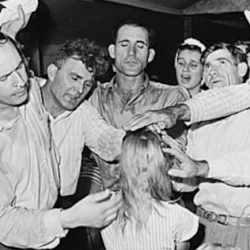Richard Rothstein’s Color of Law demonstrates that “until the last quarter of the twentieth century, racially explicit policies of federal, state, and local governments defined where whites and African Americans should live” (vii). Segregation didn’t just happen. It’s the result of deliberate policy.
The book is full of unsettling vignettes, like this: “in 1954, one resident of a whites-only area of East Palo Alto . . . sold his house to a black family. Almost immediately Floyd Lowe, president of the California Real Estate Association, set up an office in East Palo Alto to panic white families into listing their homes for sake, a practice known as blockbusting. He and other agents warned that a ‘Negro invasion’ was imminent and that it would result in collapsing property values. Soon, growing numbers of white owners succumbed to the scaremongering and sold at discounted prices to the agents and their speculators. The agents, including Lowe himself, then designed display ads with banner headlines—‘Colored Buyers!’—which they ran in San Francisco newspapers.” They sold homes to black families at inflated prices and the California real estate commission refused to take action.
Many private actors, and leaders at various levels of government, cooperated to create and preserve segregation. But the federal government has been one of the most egregious offenders. At the time of the events in East Palo Alto, the FHA and the VA refused to insure mortgages to African Americans in white neighborhoods, or whites in black neighborhoods: “Within six years the population of East Palo Alto was 82 percent black. Conditions deteriorated as African Americans who had been excluded from other neighborhoods doubled up in single-family homes. Their East Palo Alto houses had been priced so much higher than similar properties for whites that the owners had difficulty making payments without additional rental incomes” (13). East Palo Alto became a slum, partly because of the federal and state housing regulations and the inaction of local regulators.
Another illustration: During World War 1, the federal government initiated 83 defense projects in 26 states, providing housing for 17,000 people: “African Americans were excluded, even from projects in northern and western industrial centers where they worked in significant numbers. Federal policy sometimes imposed racial segregation where it hadn’t previously existed, forcing African Americans into overpopulated slums.” With the New Deal, federal housing projects were started for those who did not work in defense. Still, “race determined the program’s design. The administration constructed separate projects for African Americans, segregated buildings by race, or excluded African Americans entirely from developments” (18-19).
The long-term effects of these policies have devastated the ability of African Americans to accumulate capital over generations. Postwar “Levittowns” established around the country enabled many to become homeowners. Thousands came to share in the American dream, all of them white. Rothstein says, “By the time the federal government decided finally to allow African Americans into the suburbs, the window of opportunity for an integrated nation had mostly closed. In 1948, for example, Levittown homes sold for about $8,000, or about $75,000 in today’s dollars. Now, properties in Levittown without major remodeling . . . sell for $350,000 and up. White working-class families who bought those homes in 1948 have gained, over three generations, more than $200,000 in wealth” (182).
As Neal McClusky observes in his CATO review of the book, “While white homeowners were living in, essentially, little banks, African Americans were often renters, accumulating no equity, or owners of far less desirable houses. It is a major reason that African Americans typically have only a tiny fraction of the accumulated wealth of whites.” Federal policy prevented accumulation.
Rothstein has written a lawyer’s brief. He takes the Supreme Court principle as a given: If segregation is de facto and not de jure, the state has no obligation to provide remedy. He disputes the Court’s facts, not its judicial reasoning: “racially explicit government politics to segregate our metropolitan areas are not vestiges, were neither subtle nor intangible, and were sufficiently controlling to construct the de jure segregation that is now with us in neighborhoods and hence in schools.” And he concludes: If it is the case that “African Americans were unconstitutionally denied the means and the right to integration in middle-class neighborhoods” and that “this denial was state-sponsored, the nation is obligated to remedy it” (xiv). In short, “most segregation does fall into the category of open and explicit government-sponsored segregation” (xv).
But there’s the rub: What sort of remedy? Rothstein throws out hypotheticals that he knows are political non-starters. He argues, for instance, that the federal government should purchase the next fifteen percent of the homes that come up for sale in New York’s Levittown (fifteen percent being the percentage of New York’s population that is African American). Those homes, which he estimates are worth $350,000 apiece, would be sold to African Americans for $75,000 “the price (in today’s dollars) that their grandparents would have paid if permitted to do so” (202). No conceivable Congress would propose, much less pass, such a program, but Rothstein offers it “to illustrate the kind of remedy that we would consider and debate if we disabused ourselves of the de facto segregation myth” (203).
Any debate about remedies has to reckon with the evidence that Rothstein presents. Any remedy will have to be disabused of the comforting myth we tell ourselves about race in America.














